-
Countries
-
Data and Analysis
-
Special Focus
-
Crisis Responses

Contact
DTMAfghanistan@iom.int
Language
English
Location
Afghanistan
Period Covered
May 01 2023
May 31 2023
Activity
- Flow Monitoring
The snapshot captures present mobility and displacement trends between Afghanistan, the Islamic Republic of Iran and Pakistan.

Contact
DTMAfghanistan@iom.int
Language
English
Location
Afghanistan
Period Covered
Apr 01 2023
Apr 30 2023
Activity
- Flow Monitoring
The snapshot captures present mobility and displacement trends between Afghanistan, the Islamic Republic of Iran and Pakistan.

Contact
DTM DRC, iomdrcdtm@iom.int
Language
French
Location
Democratic Republic of the Congo
Period Covered
Feb 13 2023
May 04 2023
Activity
- Mobility Tracking
- Baseline Assessment
L'OIM - par le biais de la matrice de suivi des déplacements (DTM) - a mené des évaluations de suivi de la mobilité (MT) depuis 2018. Ces exercices sont mis en œuvre dans les provinces de l'Ituri, du Nord et du Sud-Kivu, et du Tanganyika, avec pour objectif de fournir des estimations sur la présence, le nombre de groupes de population affectés (PDI, rapatriés), les raisons du déplacement, la durée du déplacement et les besoins spécifiques dans des lieux définis.
Dans les quatre provinces de l'Est de la RDC, qui comprennent les provinces de l'Ituri, du Nord-Kivu, du Sud-Kivu et du Tanganyika, DTM a identifié 6.135 363 personnes déplacées internes (PDI) et 3 967 874 personnes retournées en avril 2023, présentes dans 67 pour cent des villages évalués. Les chiffres globaux des PDI sont les suivants : 41 pour cent des PDI (2..544..880 personnes) se trouvent au Nord-Kivu, suivis de 28 pour cent (1 727 808) a l'Ituri, 25 pour cent (1 514..280) au Sud-Kivu et 6 pour cent (348 395) au Tanganyika. Parmi les personnes déplacées en famille d'accueil, les raisons principales du déplacement sont : les attaques des groupes armés (84..%), le conflit intercommunautaire (12..%) et le catastrophe naturelle (3 %). Lors de l'évaluation, il est estimé à 1 082 015 le nombre de personnes deplacées en raison de la crise M23, dont une proportion importante (22 %) en sites et centres collectifs.

Contact
DTM DRC, iomdrcdtm@iom.int
Language
English
Location
Democratic Republic of the Congo
Period Covered
Feb 13 2023
May 04 2023
Activity
- Mobility Tracking
- Baseline Assessment
IOM - through the Displacement Tracking Matrix (DTM) - has conducted Mobility Tracking (MT) assessments since 2018. These exercises are implemented in Ituri, North and South Kivu, and Tanganyika provinces with the objective of providing estimates on the presence, number of affected population groups (IDPs, returnees), reasons for displacement, length of displacement and specific needs within defined locations.
The summary statistics presented in this report are pulled from the latest Mobility Tracking rounds for each province which took place between February and May 2023 to produce an aggregated overview of the displacement situation in the eastern DRC. In the four eastern provinces, comprising Ituri, North-Kivu, South Kivu, and Tanganyika, in April 2023 DTM identified 6,135,363 internally displaced people (IDPs) and 3,967,874 returnees, present in 67 per cent of assessed villages. DTM estimates that the highest proportion (41%) of IDPs (2,544,880 individuals) are in North Kivu, followed by 28 per cent (1,727,808) in Ituri, 25 per cent (1,514,280) in South Kivu and 6 per cent (348,395) in Tanganyika. Among displaced people living in host families, the main reasons for displacement are attacks by armed groups (84%), inter-community conflict (12%) and natural disasters (3%). At the time of the assessment, an estimated 1,082,015 people were displaced by the M23 crisis, including a significant proportion (22%) of those in collective sites and centers.

Contact
dtmhaiti@iom.int
Language
English
Location
Haiti
Period Covered
Jun 06 2023
Jun 15 2023
Activity
- Mobility Tracking
- Event Tracking
The objective of the Emergency Tracking Tool (ETT) is to collect information on large and sudden population movements as well as security and climatic emergencies. Information is collected through phone interviews with key informants and direct observation.
This information was gathered following the floods in Haiti on June 3, 2023, which affected the inhabitants of several communes and led to the creation of nine new sites. The assessments were carried out with key informants by telephone. A displacement assessment of Metropolitan zone will follow this ETT. Following ETT 18.1 and 18.2, we launched our flood data collection tool with our key informants from June 6 to 15 in the West department, covering 16 communes, 62 communal sections and 352 neighborhoods. This data enabled us to update our estimate of the total number of displaced people. The results show that 9,119 people are internally displaced, including 1,826 households. Of these, 5,009 people are living in sites, including 1,166 households.
Monthly Overview of:
- Arrivals in the Western Balkans
- Top three nationalities at arrivals in the reporting month
- Migrants presence in reception facilities
- Migrants presence outside reception facilities
- Ukrainian nationals in the Western Balkans
- Returns and reintegration
This document presents an analysis of interviews conducted with all individuals assisted in their voluntary return by the International Organization for Migration (IOM) between 2017 and 2022 (163,259) to one of the 23 countries covered by the West and Central Africa region (WCA). The analysis combines datasets from both Assisted Voluntary Return and Reintegration (AVRR) and Voluntary Humanitarian returns (VHR).
Contact
DTM Sudan, DTMSudan@iom.int
Location
Sudan
Activity
- Mobility Tracking
- Baseline Assessment
Period Covered
Apr 15 2023 -Jun 18 2023
From 15 April 2023, armed clashes erupted between the Sudanese Armed Forces (SAF) and the Rapid Support Forces (RSF) in multiple cities across Sudan, including Khartoum, Al Fasher, Kebkabiya, Merowe, Nyala, Zalingi, Ag Geneina, and El Obeid. DTM Sudan has been receiving reports of widespread displacement across different states in Sudan due to the ongoing security situation.
- DTM Sudan estimates that, since 15 April 2023, approximately 1,965,946 individuals (393,683 households) have been displaced internally as a result of the conflict. Notably, the current estimate for displacement in the previous 59 days is greater than that of recorded displacement during the previous four years.
- Furthermore, an estimated additional 598,883 individuals have crossed into neighbouring countries.
Due to the ongoing nature of the fighting, many areas reportedly remain inaccessible to field teams. DTM estimates of displacement are based on preliminary reports from field teams and should be taken as estimations only. Additional reports of displacement are likely to emerge as the situation becomes clearer.
Disclaimer: DTM Sudan notes that military clashes remain continuous in many areas across Sudan in particular in Khartoum and the Darfur region – limiting humanitarian access. Additionally, field teams have reported severe telecommunication and connectivity issues, as well as escalating economic pressures which have impacted the capacity for domestic travel. As such, DTM is currently conducting remote interviews with key informants across its network and is currently unable to engage in the additional verification of these figures. Data on flows into neighbouring countries is based on available information from DTM flow monitoring networks and secondary sources.
Population Groups
Survey Methodology
Unit of Analysis Or Observation
Type of Survey or Assessment
Keywords
Geographical Scope
Administrative boundaries with available data
The current dataset covers the following administrative boundaries

Contact
DTM Chad, dtmtchad@iom.int
Language
French
Location
Chad
Period Covered
Jun 17 2023
Jun 17 2023
Activity
- Survey
- Flow Monitoring Survey
- Flow Monitoring
Au cours des dernières 48 heures, au moins 15 000 personnes fuyant l’insécurité à El Geneina dans l’Ouest du Darfour sont arrivées dans la localité d’Adré, dans la province du Ouaddai à l’Est du Tchad. L’OIM a reçu des estimations selon lesquelles 3 000 de ces personnes seraient des retournés tchadiens. Les opérations d’enregistrement sont en cours et sont menées conjointement avec la CNARR et le HCR. Au Lycée Issakha Haroun, l’OIM a déjà fixé 1 567 personnes. 150 personnes supplémentaires ont trouvé refuge dans la localité de Noura Alhouda. De nombreuses personnes déplacées ont été blessées et ont besoin de soins médicaux immédiats car la capacité de l’hôpital le plus proche est mise à rude épreuve. Les autres besoins immédiats signalés incluent la nourriture, l’eau, l’hygiène et l’assainissement. De nombreux enfants non accompagnés ont également été signalés.

Contact
DTM Chad, dtmtchad@iom.int
Language
English
Location
Chad
Period Covered
Jun 17 2023
Jun 17 2023
Activity
- Survey
- Flow Monitoring
In the past 48 hours, an estimated arrivals of at least 15,000 have crossed into Chad from El Geneina in West Darfur, Sudan, to seek refuge in the locality of Adre, in the Eastern Chadian province of Ouaddai due the significant deterioration of the security situation and steep uptake in violence. IOM received estimates that 3,000 of the arrivals are Chadian returnees. Registration is ongoing and being conducted jointly with CNARR and UNHCR. At the Lycée Issakha Haroun, IOM has already fixed 1 567 individuals. An additional 150 people found refuge in the second site of Noura Alhouda. Many displaced persons have been injured and are in immediate need of medical attention as the capacity of the nearest hospital is being stretched thin. Other reported immediate needs include food and WASH. Many unaccompanied children have also been reported.

